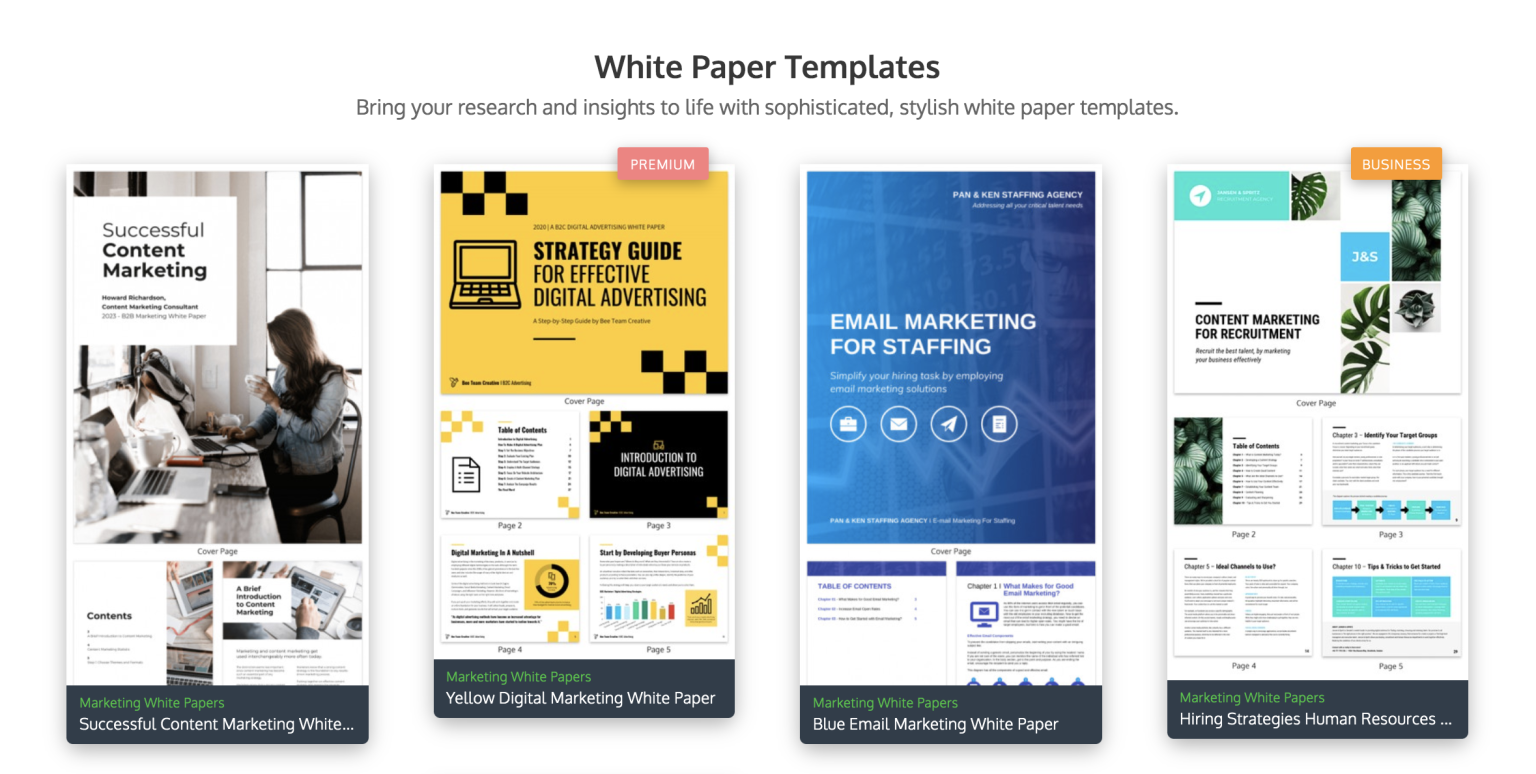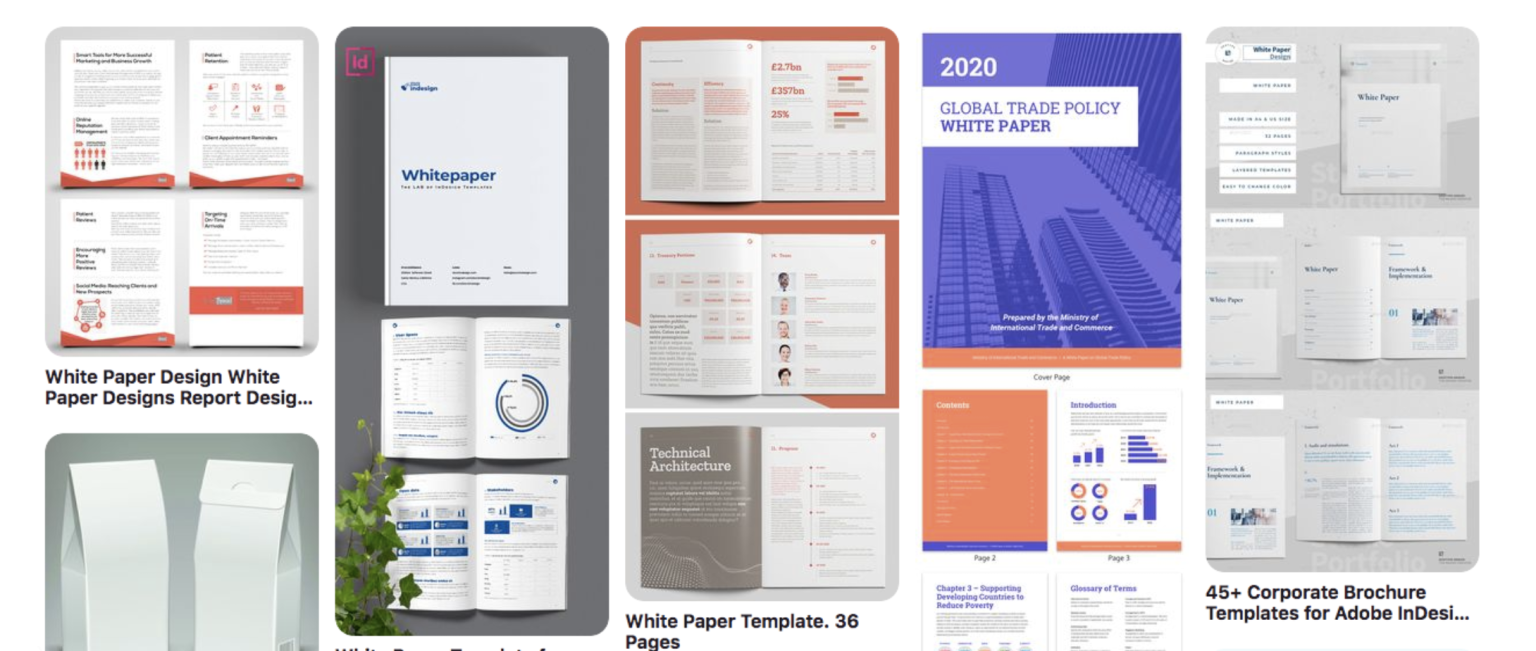To everything there is a season, and when content marketers need an asset for lead nurturing, they often turn (turn, turn) to white papers.
A long-form type of content, white papers can be high-performing assets for all sorts of brand goals, whether customer education, thought leadership or lead generation.
However, it takes a lot more work to publish a white paper than it does a blog post. While you might be able to churn out blog posts like clockwork, white papers often entail a lot of original research, professional writing and design formatting.
Need help establishing a more iterative process for creating white paper content? Consider using white paper templates.
We’ve picked out a few of our favorite templates, but before we get to those, let’s back up and examine what makes a good white paper in greater detail.
What Is a White Paper?
You might get a different answer to the above question depending on whom you ask. For example, in financial services or government a white paper is typically an extensive policy document that can reach up to 100 pages.
In the content marketing world, a white paper is much shorter. A typical marketing white paper ranges from 5 to 10 formatted pages. However, it retains many of the same themes of original research and extrapolation of the subject matter. The best way to understand exactly what a white paper is to understand what it’s not:
- Blog: Unlike your standard article, a white paper gives you far more room to do a deep dive into your topic. However, blogs can be a great way to pull and repurpose ideas from your eBook into more digestible, short-form content. We’ll get into that shortly.
- eBook: Although there’s plenty of overlap, eBooks are often for a broader audience in your target market, whereas a white paper can be used to speak to a more niche subject. Additionally, although it’s important to have a well-designed format for your white paper, eBooks are more visually driven.
- Case study: Your basic case study provides a real-world example of how your product or service solution has solved an issue. On the flip side, a white paper might highlight the benefits and rationale for implementing said product or service. Similar, but still just different enough.
According to Semrush, the use of highly informative content like white papers and eBooks is continuing to grow, with marketers ranking educational guides as one of the top 5 most effective tools in their content arsenal.
When it comes to creating your own white paper, there are several different types, which mostly boil down to your marketing strategy. This can include writing for educational purposes, positioning your brand as a thought leader or proving your expertise with a more technical paper. No matter your goals, the added length allows your content marketing team to dive deeper into the benefits of your products and services or a particular industry trend that you want to lean on.
Why Write One – Inbound Marketing Potential and Additional Benefits
If you really need a reason, here are a couple:
Essential B2B Marketing Material
White papers are particularly valuable content assets in B2B marketing. Products and services oriented toward organizations may need more space for explanation than a blog post.
Business prospects will likely ask for more details on products and services – which you can efficiently deliver through a white paper.
In a 2019 survey on B2B content marketing from Demand Gen Report, 56% of respondents said white papers were valuable early-stage content pieces; 33% said the same about white papers as mid-stage content.
Perfect Gated Asset
Email addresses are gold for content marketers, and many online users are willing to exchange their info for a relevant white paper.
As such, white papers can be potent lead generation tools. Depending on your distribution strategy, you may opt to gate the white paper on a landing page with a fill-out form. Just ask for a few bits of information, like name and email address. Too many questions — e.g., industry, role, location — can create a higher barrier to downloads.
Highly Shareable
When you produce content, you ideally want readers to share your assets with others. White papers, as the Demand Gen Report found, are actually the most likely type of content to be shared with colleagues.
55% of respondents said they shared white papers, more than the number who said they shared webinars, case studies, video content and infographics.
While a white paper may not immediately strike you as a shareable asset, a well-crafted white paper can spread like wildfire on social media or within professional circles and increase your brand awareness.
Researching Your White Paper Topic and 5 Other Key Steps
Having a white paper template is going to make the creative process that much easier. And once you find a couple preferred templates, the process will be even more streamlined, allowing you to consistently produce high-quality white paper content.
More on that in a bit.
Until then, here are some fundamental steps to publishing a white paper.
1. Define Your Target Audience
Who is reading your white paper? More importantly, who are the readers you want to be reading your white paper?
As with any other content type, white papers need a target audience. Before doing any writing, your team needs to define the ideal reader and their motivations. Your target audience may be C-suite executives, department heads or procurement decision-makers. In any case, have a concrete definition of your audience in hand before doing anything else.
2. Do the Research
Readers expect more from white papers, whether deeper insights or thought leadership they can’t find anywhere else. A high-quality white paper will deliver on these expectations.
Your marketing team will need to roll up their sleeves and do some original research to speak knowledgeably about the topic. This may entail internal interviews with your product leads or other subject matter experts. At a minimum it means collecting an array of sources to back up your white paper.
3. End With a Flourish
White paper conclusions give you a chance to make an impact on readers. They have invested their time, and by the end expect a close that summarizes everything neatly and provides them with key takeaways.
Put as much effort into writing conclusions as you do your introduction – and don’t forget calls to action. CTAs need to be clear, specific and relevant to the white paper.
4. Format the Copy with Design Elements
The white paper design you choose will have a major effect on how the content is received. White papers can absolutely be creative documents, not just droll pages of chunky text.
At the least, incorporate your brand color scheme into the white paper format. But also consider adding:
- Pull quotes.
- Photos/images.
- Illustrations.
- Charts and graphs.
Design elements will not only help break up the copy, but also reinforce key takeaways you want to impress upon readers.
5. Determine Your Distribution Strategy
First off, decide on the file type for your white paper. PDF is likely the most common file format, but Word docs may also work. If you format your white paper in HTML5 or Adobe InDesign, however, you can add interactive design elements that bring your content to life.
In terms of marketing channels, think about distributing your white paper through email campaigns, social media or as a “thank you” for attending a webinar. Always be sure to build out a landing page and a form for your white paper to collect lead information.
6. Promoting Your White Paper in the Long Term
If you’re not seeing the traction you expected from your white paper, there are several strategies you can use. Some important tactics to consider include:
- Add to the resource section of your website: If you haven’t already, be certain to highlight your white paper at the top of your resource section. Another way to draw attention to your new content is to create a dedicated white paper tab.
- Create internal links: Go through old and new blogs and link to your white paper’s landing page when relevant. This will not only drive traffic, but it’ll also provide readers with more valuable information.
- Attend industry events: Whether you host a virtual event of your own or attend an industry-wide gathering, sharing insights from your white paper can be a great way to generate more attention.
Just remember that no matter how you plan to promote your white paper, it should be done in a way that’s relevant to your target readers.
What Does a Great White Paper Look Like?
Templates can help accelerate your creative process. You might even have your own internal templates that have brand guidelines built in. Otherwise, if you’re looking for a good white paper template, we have a few in mind:
Adobe Creative Cloud Express
Adobe Creative Cloud Express offers its users an array of templates that feature tons of options when it comes to customization, including branded colors, high-definition logos and in-text infographics.
You can explore Adobe’s professionally designed templates on its website, however keep in mind that some of the more advanced features do come at a cost.
Venngage
Venngage has a wide variety of templates, with many designed for particular purposes, including content marketing white papers and human resources white papers.

You can check out their site for the full complement of white paper templates. You can access some with a free account, while others require a premium account.
Lucidpress
Lucidpress has hundreds of content templates, and a handful of white paper templates. We like these because of the balance the templates give between copy and design elements.

You can sign up with your email address to customize the template.
Visme
Visme is another provider of templates, with a few white paper formats that really catch the eye.
 Like with other providers, you’ll need to register for a free account, though most Visme templates are premium. If you do upgrade, you’ll get access to a range of templates that offer high-quality visuals that can bring your copy to the next level.
Like with other providers, you’ll need to register for a free account, though most Visme templates are premium. If you do upgrade, you’ll get access to a range of templates that offer high-quality visuals that can bring your copy to the next level.
Trying heading over to Pinterest and searching “white paper templates.” You’ll get tons of results for white papers of all kinds.

You can add on other keywords like “B2B marketing” or “company policy” to find white paper templates specific to your use case.
Create Your Own White Paper Template
If you have enough internal resources, think about creating a range of white paper templates. Investing the effort now can lead to more seamless content production down the line, including rapid iteration of white papers to respond to current events or explain product updates.
Just make sure that your template features:
- A cover page.
- A table of contents.
- An introduction.
- Main copy pages with branded elements.
- A conclusion with a clear CTA.
- An ending “contact us” page.
Be sure to have your color scheme interwoven throughout the template, and leave designated space for graphics, visuals, custom illustrations, charts and other design elements.
Repurposing Your White Paper Content
Now that you’ve spent all of this time developing a best-in-class white paper, it’s time to get your full investment of your hard work.
One of the biggest advantages white papers have over other forms of content is that they’re almost chameleon-like in nature. You can pull and reshape information from your existing paper to create entirely new spin-off campaigns such as:
- Social media posts highlighting key data points or major trends you’ve discovered.
- Blogs that serve as a primer on a smaller section of the white paper or as a deeper dive into a topic that was mentioned on a higher level.
- Email campaigns that leverage the white paper as a way to offer value to new or existing customers.
No matter which white paper template you decide to use or develop on your own, be sure to make good use of it. White papers are valuable content types for all customer demographics and effective lead gen tools — but only if they are high quality and targeted. Templates help you more consistently create at that level.
Ready to create your own white paper? We’ve put together this handy White Paper Template to help you get started!






